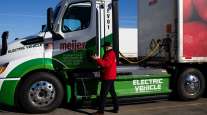Senior Reporter
Daimler Truck Shares Details on Plans Post-Spinoff

[Stay on top of transportation news: Get TTNews in your inbox.]
Daimler Truck AG, the largest global truck maker, intends to go public Dec. 10, and recently described what that would look like in terms of products and performance.
Two-thirds of the salary of each member of its board of management will involve incentives tied to company performance as the truck maker more thoroughly embraces battery-electric vehicles, hydrogen fuel cells and autonomous trucks, and adds related services and carefully begins to ramp down its internal combustion engine business — pursuing increased margins along the way.
Daimler’s move to an independent company has two overarching goals: “to strengthen profitability and lead the way to zero emissions,” Daimler Truck AG CEO Martin Daum said during the Daimler Truck Capital Market Day virtual presentation from Germany Nov. 11.
We are ready for #independence! Prior to the planned stockmarket listing set for December, we are hosting our Capital Market Day today & detailing our continued ambition to lift performance and enhance profitability. Check it out! #WeAreDaimlerTruck #ListedInFrankfurt — Daimler Truck AG (@DaimlerTruck) November 11, 2021
“We believe we have all the things in place to be successful right from the start,” Daum said. “We can’t wait to take our future in our own hands as entrepreneurs. We can’t wait to step into the spotlight and to show the world what we are capable of.”
He said zero-emission vehicles “should enable new revenue models to drive our service targets.” That includes consulting on electric vehicle infrastructure and expanding its connected vehicle platform, which included 300,000 North American trucks as of September.
Under the fast-approaching realignment of parent company Daimler AG, the truck and bus unit will become Daimler Truck Holding AG, which will be publicly traded on the Frankfurt Stock Exchange. Also, Daimler AG will be renamed Mercedes-Benz Group AG effective Feb. 1.
Daum said the company looks to achieve an adjusted return on sales by 2025, at least, of “6% even in a rainy scenario. In an average market environment, we want to aim for 8% to 9%. And in sunny conditions, we aim to deliver more than 10%.”
He explained a sunny environment is a year with 500,000 global truck sales spanning its key markets in Asia, Europe and North America.

Daimler
Daimler customers in North America won’t notice anything different in a negative sense after Daimler’s move to independence, Daimler Trucks North America CEO John O’Leary said. He spoke via Zoom in a separate meeting with North American reporters after participating in the virtual presentation from Germany.
“What customers will ultimately see is better technology at a better price, over time, just as they do today with Detroit Diesel engines and the safety systems and Detroit Connect,” O’Leary said.
He said DTNA will launch a third new vocational truck in 2022. That will come on the heels of its 47X weight-sensitive model launched in September, and the 49X launched a year earlier into what he called a smaller but highly profitable segment of the truck market.
DTNA spent $380 million on the “full model refresh” of its heavy-duty vocational products, O’Leary said. And Western Star is on track to sell more vehicles in 2022 than in any other year in its 54-year history.

For Veterans Day, host and Navy veteran Michael Freeze sits down with Army veterans James Rogers, owner of Spartan Direct Trucking Co. and 2020 Transport Topics Trucking's Frontline Hero, and John Baxter, equipment columnist. Hear a snippet above, and get the full program by going to RoadSigns.TTNews.com.
Heavy-duty vocational trucks are kept longer compared with on-highway trucks, he said. “As a result, they go out the door content-rich and with excellent margins,” adding “even as we work to grow our vocational share, we will vigorously defend our on-highway leadership.”
He believes DTNA’s aftermarket network is “perhaps the greatest factor in allowing us to maintain the fierce customer loyalty that we have.”
It includes more than 1,150 locations. DTNA plans to grow dealer rooftops by 30 locations and 500 service bays in the coming 18 months, O’Leary said.
DTNA has 12 parts distribution centers. They collectively ship 170 truckloads of parts per day and get 90% of ordered parts to their destinations in 12 hours or less, he said. “We are set to capitalize on this further by strengthening our parts distribution channel to support our lift and shift toward increasing online parts sales.”
Meanwhile, Andreas Gorbach, Daimler Truck’s chief technology officer, said the truck of the future will be a programmable device. “Therefore we will push the next evolution of the mechatronic architecture [mechanical systems augmented with electronics] and develop a truck-dedicated software operating system,” he said.
Daimler intends to redirect the majority of spending on research and development to zero-emission vehicle technologies by 2025.
Gorbach said achieving total cost of operations parity with diesel is the most important factor in timing the shift to zero-emission vehicles.
Want more news? Listen to today's daily briefing below or go here for more info:




